Blog from MBP Volunteer, Jack
Anyone flying into Madagascar for the first time can expect to feel more than a little nervous. The excitement of planning your trip to the jungle and see the unique wildlife and endearing lemurs will by then have subsided only to be replaced by a sense of trepidation. What is this barren moonscape the plane is flying over? Not a single lemur or chameleon waving to greet me from its forested home. In fact Tana lies in the high altitude section of Madagascar; sheltered by the mountains that flank the whole of the eastern coast of the island, and thus the climate in the city is comparatively mild.
The first glimpse of Malagasy culture hits you right off the plane. The airport in Tana is more akin to a provincial bus station than an international transport hub. The system for getting your visa stamped is more than a little confusing. The whole processes seemed to be overseen by a boy of around sixteen in a baggy t-shirt and straw hat. I stood in the tourist ‘queue’ surrounded by a plethora of elderly British women. Protests of “we need a better queuing system than this” and “what have you done with my passport?” were duly shrugged off. The first introduction to the Madagascan philosophy: hurry up and wait. Airport formalities dealt with the volunteers are met by MBP staff outside the airport. Jet lagged and bemused, your bags are placed into a taxi which, after being jump started, begins the journey into the centre of Tana.
From behind the dusted glass of the window of the grunting taxi you view the journey into the city. The road remains quiet for a while trudging  through the outskirts. Butchers shops selling freshly hacked zebu meat left to hang in the tropical sun. The sides of the squat houses painted numerous colors brandishing signs, adverts and slogans or maybe just showing off the flare of the owner. People mull around the street, children playing with makeshifts toys, bike wheels, sticks or just slung on the back of their mothers, tied loosely with the Malagasy staple: the lamba. In essence a sarong, which is worn by Malagasy women and used for innumerable tasks.
through the outskirts. Butchers shops selling freshly hacked zebu meat left to hang in the tropical sun. The sides of the squat houses painted numerous colors brandishing signs, adverts and slogans or maybe just showing off the flare of the owner. People mull around the street, children playing with makeshifts toys, bike wheels, sticks or just slung on the back of their mothers, tied loosely with the Malagasy staple: the lamba. In essence a sarong, which is worn by Malagasy women and used for innumerable tasks.
Eventually the road passes through an open area of paddy fields dotted with the white backs of cattle egrets. In the morning sunlight it appears more of a relaxed town than a bustling capital city. Heading further into town the tranquility subsides and the crazy of the city takes hold. You fight your way through markets selling everything from old shoes and clothes to mountains of sliced vegetables, tropical coleslaw I never did come to understand. The car passes by the city’s central lake, the queen’s palace can be seen on the hill and below it the Tana version of the ‘Hollywood’ sign. A dusty back road leads to the lush garden and the MBP office compound.
After a day or two sorting visas and obtaining supplies the trip begins to KAFS. The first few hours of the trip are spent in the high mountain plateau. The roads are lined with makeshift kilns, used by villagers to bake the mountain clay into building material. The highland houses demonstrate a fascinating blend of African architecture and colonial influence. Mostly built from mud bricks and thatched with rice straw many also have elaborate verandas, beautifully carved shutters and multiple stories, some up to four floors high. On this part of the journey you will not see any forest. The dry highland zone may have harbored a dry deciduous forest at some point but this is long gone. In such an arid climate firewood is a vital resource, and for a villager eking out a living here the tree simply means food and warmth.
Some hours later the car turns off the main road to begin the decent from the highlands into the tropical forest waiting below. The giant cliff faces and mountains on this side of the island trap most of the rain coming off the Indian Ocean. It can rain up to 5m a year here and thus the landscape has become teeming with plant and animal life found nowhere else on the planet. The road descends through Ranomafana National Park; still at altitude this is an area of cloud forest where rain is abundant but temperatures less stifling than the lowlands. The tangle of vines and massive forest trees reach right up to the road, this is lemur country. As the road descends further the heat gets more stifling, the humidity sweats and rots the landscape and the biting insects, so abundant here, make themselves known.
The road stretches past Ranomafana descending further down into the heat and humidity. Don’t expect to see pristine forest here, for centuries the way of life of villagers here has been ‘tavy’ which is the slashing and burning of forest to make space to grow crops to survive. Although 90% of the original forest is now gone what is left is teeming with life you will find nowhere else on earth. The architecture changes here too, houses are built from wood and thatched and walled with ravinela, the traveler’s palm, a tree endemic to Madagascar for which the locals have countless uses. As night begins to fall you reach the Kianjavato commune and turning the corner of the final pass the mountain of Vatovavy comes into view. This island of beautiful primary rainforest will be on the horizon for the next few months, its presence almost volcanic when viewed early morning with sun rising behind. Finally the car draws into the field station, greetings and pleasantries done with and equipment unloaded your mountain of rice is served. A carbohydrate Vatovavy of your own; your meal for the next six months.
Jack
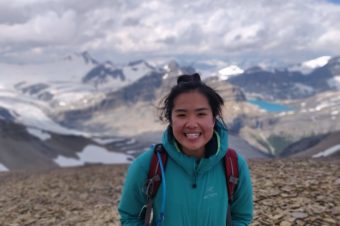


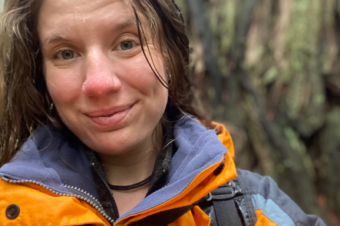

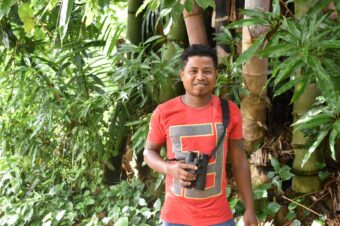


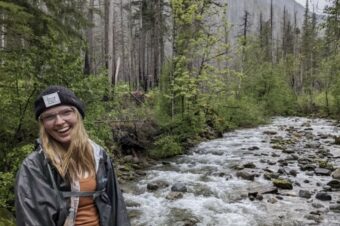
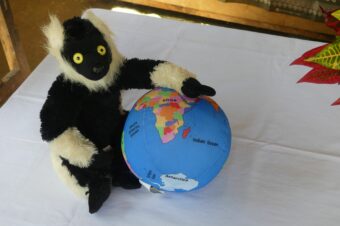
Leave a Reply